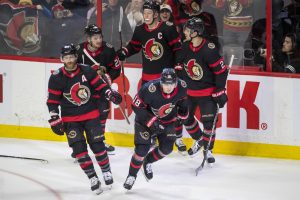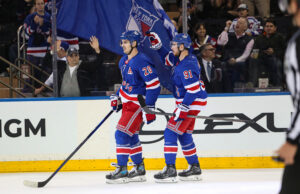The History of Trade is a mini series going through each team’s best and worst trades of all time. Each team has their own history and some may cross over, but the series will try to stick to each team. This article will focus on the Minnesota Wild trade history, finding the best and worst of all time.
Minnesota Wild Trade History: Best and Worst Trades of All-Time
The team with the fewest trades in NHL history, save for the Vegas Golden Knights, the Minnesota Wild may not have been part of any blockbuster deals. But, that is not to say they haven’t had franchise defining moves. Both the best and the worst trades have resulting in change in the team that is still felt today.
Best Trade
As mentioned, the Wild may not have made any true blockbusters. They have brought in pieces throughout their short history but never went big on a big name. Instead their best trade actually was a throw away player who turned the team into playoff contenders.
The Trade
The Minnesota Wild acquire Devan Dubnyk from the Arizona Coyotes for a 2015 third round pick (Brendan Warren) (later traded to the Philadelphia Flyers)
Traded Away
Now it’s hard to say who the Wild would have taken with a draft pick. When you look again and realize it was a third rounder you understand that this trade was a throw away. The Coyotes would go on to draft Brendan Warren out of the US National development team. He had 13 points in 20 games his draft year. Since then he has played two seasons at the University of Michigan totalling 27 points in 83 games.
He has yet to make the transition to pro hockey and was actually traded to the Philadelphia Flyers this past off-season along with Arizona’s fifth round pick in 2018 for Merrick Madsen and Nick Cousins. To truly rate this trade we have to wait and see how Cousins does in Arizona. If history of Cousins play is any indication this trade will forever be one sided.
The Return
Dubnyk has been a conundrum since he entered the league. His first season with the Edmonton Oilers saw him put up a 3.57 goals against average and win only four games in 16 starts. His second season saw him increase his win total to 12 while posting a 2.71 goals against average. The next three seasons saw the inconsistency continue, with an eventual trade to the Nashville Predators.
Entering the 2014-15 season not much was expected of Dubnyk in Arizona. He was supposed to be the backup behind Mike Smith and would play only 19 games prior to the trade. His numbers were good, a .929 save percentage and 2.72 goals against average, but this trade was just supposed to help Minnesota get to the playoffs. Darcy Kuemper and Niklas Backstrom were both struggling so the Wild saw an opportunity to bring in a veteran to push them.
What was not expected was what happened next. He would go on to start a Minnesota record 38 straight games after the trade. His numbers over that stretch were astounding as he posted a 1.78 goals against average and a .936 save percentage. He managed 27 wins during his streak and propelled the Wild from eight games out of a playoff spot to the top wild card spot. He would get the Wild into the second round of the playoffs after beating the St. Louis Blues in six games.
Since then Dubnyk has been one of the most consistent goalies in the NHL. The past two years have seen him post seasons of 32 and 40 wins respectively. He has also managed to keep his goals against average below 2.33 while maintaining a .918 save percentage or better. His presence has become a solidifying factor for the Wild, who have made the playoffs each season he has been with the team. Seeing as he is only 31, he could remain in the league for years to come. If he continues at this rate, who knows how one sided this trade will look five or ten years from now.
Honourable Mentions:
The Minnesota wild trade Ryan Jones and a 2009 second round pick (Charles-Olivier Roussel) to the Nashville Predators for Marek Zidlicky, Minnesota acquires Nino Niederreiter from the New York Islanders for Cal Clutterbuck and a 2013 third round pick (Eamon McAdam), Minnesota acquires Willie Mitchell and future considerations from the New Jersey Devils for Sean O’Donnell
The Worst
While the best trade brought a relatively underperforming player to Minnesota, the worst trade was much different. Instead of sending a relative unknown commodity away, they sent a proven defensive stalwart and blossoming offensive talent for young pieces that never really panned out.
The Trade
Minnesota trade Brent Burns and a 2012 second round pick (Pontus Aberg) (later trade to the Tampa Bay Lightning and then the Nashville Predators) to the San Jose Sharks for Devin Setoguchi, Charlie Coyle, and a 2011 first round pick (Zack Phillips)
Traded Away
Giving up a second round pick usually does not leave a hole in a roster. In this case the Wild lost nothing. But the pick turned into a fairly good prospect. After the pick was traded again to the Predators, Nashville picked Pontus Aberg. Aberg has only managed 15 games in the NHL for the Preds, but last year he put up 52 points in 56 games for the Milwaukee Admirals and he looks to be a possible fill for the loss of James Neal in Nashville this season.
Brent Burns on the other hand left a massive hole in Minnesota. The top pairing defenseman, with the ability to play forward, was a staple on the Wild defense for seven seasons. Despite dealing with some injuries during the 2008-09 and 2009-10 seasons, Burns showed offensive potential while being a wall on the blue line. His big frame allowed him to smartly play the body while still staying in position.
After being sent to the Golden State, Burns joined a young defensive core that included Marc-Edouard Vlasic (24), Justin Braun (24), and Jason Demers (23). As a 26-year old, Burns came in with a veteran presence and really found his game with the Sharks. Playing the top pair against some of the best players in the league Burns not only shut down those players but became an offensive wizard from the point. He increased his point production every year except the lockout shortened 2012-13 season.
The last three years have seen him put up totals of 60, 75 and 76 respectively. His 29 goals last season was the most goals by a defenseman since Mike Green put up 31 in 2008-09. Outside of the numbers, Burns has become one of the most well known players in the league. His look alone is one of the most recognized in the league, making him a marketing gold mine.
Burns has gone on to be a perennial Norris trophy candidate, finally winning his first in 2016-17. Had Minnesota never traded him, the outcome of both Burns’ career and the Wild franchise may be very different right now.
The Return
The draft pick that the Wild received ended up being first round pick Zack Phillips. Phillips was the 28th pick that year, but has yet to play a game in the NHL. After toiling in the minors, splitting time in the AHL and ECHL, he headed over to Europe last season. His NHL dream may never come to fruition.
Both players the Wild received were also first round picks. Setoguchi was supposed to be the big player heading to Minnesota in this deal. The former eighth overall pick, Setoguchi showed signs of being a big name player in his second season. He managed to score 31 goals and put up 65 points that year. He would see his numbers drop the next two year, only managing 36 and 41 points.
After arriving in Minnesota, Setoguchi’s numbers never returned. He would see his offensive production slip in both seasons he played for the Wild. Setoguchi was eventually traded to the Winnipeg Jets for a second round pick which was later traded to the Buffalo Sabres in the Matt Moulson trade. He has continued to struggle and has only managed to play in 57 games in the past three seasons.
Charlie Coyle was a young prospect when he was sent to Minnesota. He has turned into a fairly decent player, managing to increase His point production in every single season in the league. He started with just 14 points in 2012-13 in only 37 games. Since then he has put up 30, 35, 42 and 56 points respectively. His 56 points last season saw him finish fifth in team scoring. Unfortunately for the team losing Burns’ presence on the back end will most likely never be filled with just offense.
Dishonourable Mentions:
Minnesota trades Dwayne Roloson to the Edmonton Oilers for 2006 first round pick (Trevor Lewis) (Later traded to the Los Angeles Kings) and 2007 third round pick (Spencer Machacek) (later traded to the Atlanta Thrashers/Winnipeg Jets), Minnesota trades Zbynek Michalek to the Arizona Coyotes for Erik Westrum and Dustin Wood
ST. PAUL, MN – DECEMBER 13: Minnesota Wild goalie Devan Dubnyk (40) makes a save in the 1st period during the regular season matchup between the Florida Panthers and the Minnesota Wild on December 13, 2016, at Xcel Energy Center in St. Paul, Minnesota. (Photo by David Berding/Icon Sportswire via Getty Images)






